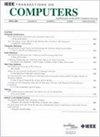从分散的变色龙哈希函数,重新审视
IF 3.6
2区 计算机科学
Q2 COMPUTER SCIENCE, HARDWARE & ARCHITECTURE
引用次数: 0
摘要
最近,可读区块链由于能够重写区块的内容而引起了人们的关注。现有的可读区块链解决方案可以分为两类,集中式和分散式。在集中式解决方案中,拥有活板门的单个区块链节点进行编修操作。然而,它们受到单点故障的困扰。在去中心化解决方案中,编校操作由多个区块链节点协同执行。但在这些解决方案中也存在效率低下或需要一个受信任的方的问题。随后,Jia等人从他们设计的去中心化变色龙哈希函数(DCH)中提出了一个可读的区块链解决方案,该解决方案支持阈值编修、可追溯性和一致性检查。然而,在仔细分析他们的解决方案后,我们发现它并没有通过提出具体的攻击来实现他们所声称的安全性。为了解决这一安全问题,我们提出了一种新的变色龙哈希函数方案,该方案在保持构建块简单高效的同时,实现了强大的抗碰撞安全性。在此基础上,我们提出了一种改进的DCH方案,该方案具有足够的安全性,使得其中的可读区块链能够抵抗所提出的攻击。理论和实验分析表明,改进后的DCH可以达到与DCH相当的效率。本文章由计算机程序翻译,如有差异,请以英文原文为准。
Redactable Blockchain From Decentralized Chameleon Hash Functions, Revisited
Recently, redactable blockchains have attracted attention owing to enabling the contents of blocks to be re-written. The existing redactable blockchain solutions can be classified as two categories, the centralized one and decentralized one. In centralized solutions, a single blockchain node possessing the trapdoor conducts redaction operations. However, they suffer from the issue of single point of failure. In decentralized solutions, redaction operations are performed by numerous blockchain nodes cooperatively. But there also exists the issue of inefficiency or requiring a trusted party in these solutions. Subsequently, Jia et al. proposed a redactable blockchain solution from a decentralized chameleon hash function (DCH) they designed, which supports the threshold redaction, traceability and consistency check. Nevertheless, after carefully analyzing their solution, we find that it fails to achieve the security they claimed by presenting a concrete attack. To resolve this security issue, we propose a novel chameleon hash function scheme that achieves strong collision-resistant security while maintaining simple and efficient as the building block. Based on it, we then present an improved DCH scheme with sufficient security, so that the redactable blockchain from it can resist the presented attack. Theoretical and experimental analyses demonstrate that improved DCH achieves efficiency comparable to DCH.
求助全文
通过发布文献求助,成功后即可免费获取论文全文。
去求助
来源期刊

IEEE Transactions on Computers
工程技术-工程:电子与电气
CiteScore
6.60
自引率
5.40%
发文量
199
审稿时长
6.0 months
期刊介绍:
The IEEE Transactions on Computers is a monthly publication with a wide distribution to researchers, developers, technical managers, and educators in the computer field. It publishes papers on research in areas of current interest to the readers. These areas include, but are not limited to, the following: a) computer organizations and architectures; b) operating systems, software systems, and communication protocols; c) real-time systems and embedded systems; d) digital devices, computer components, and interconnection networks; e) specification, design, prototyping, and testing methods and tools; f) performance, fault tolerance, reliability, security, and testability; g) case studies and experimental and theoretical evaluations; and h) new and important applications and trends.
 求助内容:
求助内容: 应助结果提醒方式:
应助结果提醒方式:


